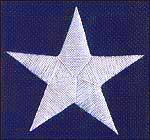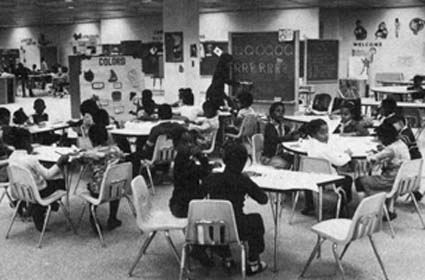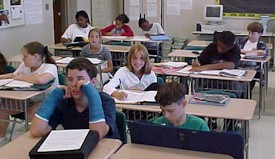


Physical Classroom Arrangements - 1897 to Present



![]()
Made In the USA!
![]()
We don't know a millionth of one
percent about anything.
Thomas Edison (1847-1931) U.S. inventor
In "1,911 Best Things Anybody Ever Said," ed. Robert Byrne, 1988.
Come celebrate almost 100 years of education in the United States! Below is a panorama of periods throughout American education and the various styles of classrooms in vogue at various times in history. We will start off with the turn of the century and show you a few of the different types of classrooms at that time and ask that you look very carefully to see what, if anything, you notice in these photographs and sketches of actual classrooms. These classrooms hail to us from a very close neighboring city -- Philadelphia, Pennsylvania. In its day, Philadelphia was the leader in the reform movement. These were not actual classrooms that you might expect to see in the rural, farm areas but were state-of-the-art at that time and examples of what people thought classrooms of the future should look like.
From 1929 through 1960, photographs and feature stories from The Nation's Schools provide us with a glimpse of the "modern" classroom. These classrooms do not necessarily reflect what all classrooms across the nation looked like but merely what someone thought they should look like. The magazine sought innovative schools to feature in its magazine so what you are seeing is the best representative sample at that time.
![]()
Pictures taken from Public Schools of Philadelphia by John Trevor Custis
Philadelphia: Burk & McFetridge Co. (1897)
Alexander Adaire School
This school was opened in 1892. It was named after a member of the Board of Education from the Eighteenth Section. At that time, it was one of the most handsome school buildings in the city. It was erected at a cost of nearly $70,000. There were twenty classes with an enrollment of over one thousand pupils. The school building itself was a model in point of construction, and was fitted up in the most modern and approved style. A notable feature which this building had in common with several other of the modern schoolhouses at that time consisted of wall maps and pictures, an innovation which had been introduced with excellent satisfaction. Philadelphia took the initiative in this mode of decorating the walls of school buildings. There were also paintings representing animals and specimens of vegetable life from all parts of the world, as well as maps. The idea was to give the pupils clearer conceptions of the objects thus represented than could be gathered from a laborious study of natural history.
Coulter Street Secondary School, Germantown
Blackboard Exercises
Francis M. Drexel School
Kindergarten Department
James Forten Elementary Manual Training School
This school was counted as a charitable institution and its purpose was to educate immigrant children. It took these children and instilled valuable lessons of country and patriotism and the merits of neatness, accuracy, truth and honesty. When first founded, the educational value of this institution was questioned and bore the name of "Miss Hallowell's experiment." Philadelphians felt that the school demonstrated its usefulness and were hopeful that opinions of educators across the country would support such a school. This was just one of the many reform movements which swept the country.
![]()
1929
The New Holbrook - Hamtramck, Michigan
This school was first erected in 1897 and added to in 1905 and 1913. The building was condemned in 1926, making necessary immediate abandonment and a decision by the board of education to rebuild or to modernize. After much debate over whether to modernize or to tear down and rebuild -- a very costly endeavor -- the board voted to modernize and the modernization was completed in 1929. The new, modern classroom was complete with high ceilings, generous blackboard space and comfortably placed desks. It is interesting to note that the modernization efforts which the board adopted were referred to as "the school plant program."
The Nation's Schools, November 1929, Vol. IV
![]()
1936
An "Experiment in Character Training"
Nature or Nurture?
In Jamestown, New York, this question was resolved in 1933 with a code of ethics to be taught by teachers (similar to that used by Boy Scouts). They ascertained that ten traits of character must be especially stressed.
1. The good citizen respects himself.
2. The good citizen respects authority.
3. The good citizen is considerate of others.
4. The good citizen is loyal to the best.
5. A good citizen is honest.
6. The good citizen meets hardship with courage.
7. A good citizen is thrifty.
8. A good citizen is dependable.
9. The good citizen is self-controlled.
10. The good citizen is self-reliant.
The Nation's Schools, July 1936, Vol. 18, No. 1
![]()
1940
Bailey Elementary School, Hillsdale, Michigan
It's 1940 and they are still referring to schools as "school plants." The debate now is over the choice of equipment and whether teachers should have more input than any other individual. They did conduct a survey comprised of the outstanding teachers and supervisors in education throughout the country and they definitely stated their preference for tables and chairs accommodating groups of four to eight, in most cases for kindergarten and grades 1 and 2. For grades 3 to 8 the majority preference was for a mixture of group tables and chairs and movable desks. This modern classroom featured movable, well-designed furniture, complete with high ceilings and generous blackboard space.
The Nation's Schools, September 1940
![]()
1952
Rosslyn Heights Elementary School
Above is a typical classroom, showing mounting of window shades at center of sash for raising or lowering. Window sills are polished terrazzo, which extends over cabinet, providing wide waterproof shelf for plants. Note that magazines are still referring to schools as "school plants."
The Nation's Schools, February 1952, Vol. 49, No. 2
![]()
1960
Cicero Elementary School (Cicero, Illinois)
Remoderling for one of five schools in Cicero, Illinois dressed up the outside, brightened up the inside, slashed heating costs and simplified maintenance.
The Nation's Schools, May 1960, Vol. 65, No. 5
![]()
1977

Friendship Elementary School, Washington, D.C.
By 1976, there was a reduction of tangible support for open classmrooms and teachers began throwing up jerry-built walls of portable blackboards and bookcases to create self-contained rooms within open-space work areas. Learning centers gradually disappeared.
How Teachers Taught, Constancy and Change in American Classrooms by Larry Cuban
Teachers College Press (1993)
![]()
1999




Woodrow Wilson Middle School
Roanoke, Virginia
https://www.roanoke.k12.va.us/woodrow/home.html
![]()
2005

Most Virginia Tech students take introductory math classes at the Virginia Math Emporium, a computer lab located in a former department store near the campus. (Photo by Jay Paul, Black Star, for CrossTalk) https://www.highereducation.org/crosstalk/ct0105/news0105-virginia.shtml
![]()
Did you know?
https://helpfrom.nea.org/esp/resource/iaq.htm
![]()
Questions to Ponder
1. Does the classroom environment itself impact the quality of learning?
2. How might teachers at the turn of the century have dealt with the prospect of teaching 75 to 100 kids and how would that of been possible? What conditions existed at that time which would have allowed this type of learning to occur?
3. Do you see any emerging patterns in educational design or classroom size?
4. Do you see any distinctions which reflect social norms?
5. Do today's classrooms reflect values and social norms of the general public?
6. What does design of a classroom tell you?
7. How important is the role of design in educational norms and values?
8. How important is the role of design in effective teaching and learning?
9. Can you design your classroom as you see fit or are you constrained in doing so? If so, by whom or what?
10. Why were schools called "plant schools" up through and including the 1950s? What is the significance of that, if any?